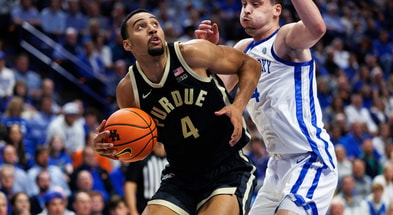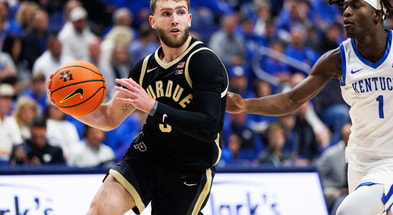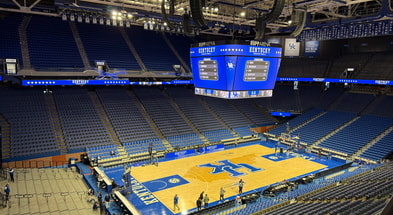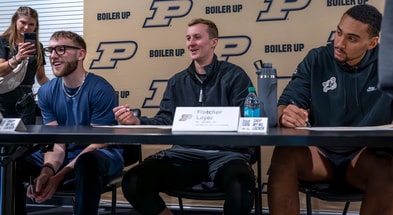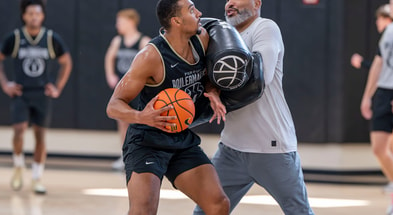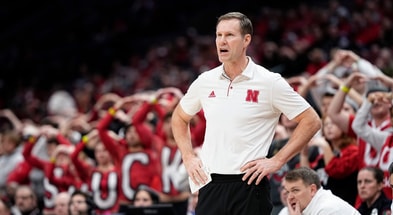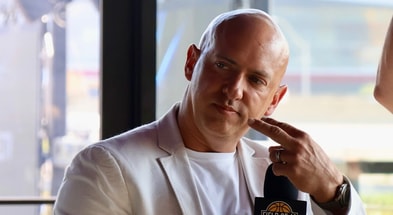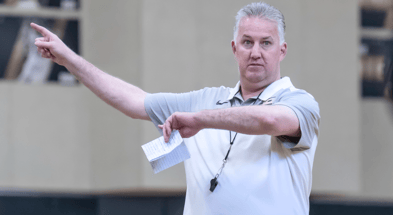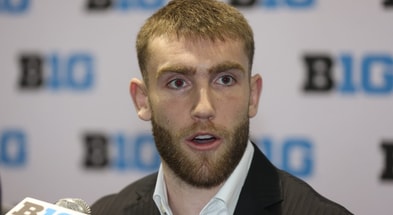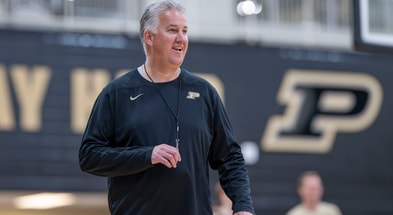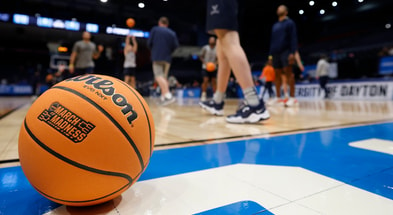Upon Further Review: Defensive approaches and more from Purdue Basketball's exhibition loss at Kentucky
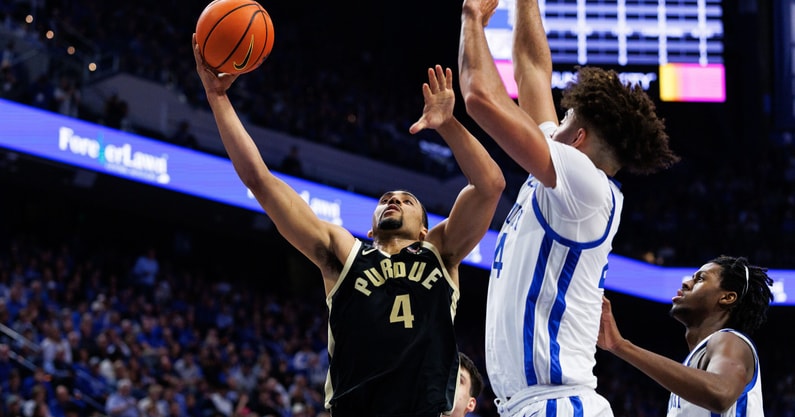
After each Purdue basketball game this season, GoldandBlack.com will take a detailed look back at the contest to highlight some of its finer points.
Today, No. 1 Purdue’s 78-65 exhibition loss at No. 9 Kentucky Friday night at Rupp Arena.
We will not go too deep on this one given the dynamics around these exhibitions, which we won’t remind you of as to not annoy BBN even more, but did want to point out a few new and notable things.
PDF: Purdue-Kentucky statistics
More: Analysis | Wrap Video | Stat Blast | Final Thoughts | Pod
DEFENSIVE APPROACHES
First of all, you know that double-teaming the post is an every-year defensive staple for Purdue. Last year, it doubled from the baseline more often than not; mostly, prior from the front/ball side.
Friday night, nothing.
Normally, with the play below, Purdue probably would have trapped the big here on the catch, try to steer him away from the paint or up against the baseline. Nuance shifts from game to game, but the point is to make a big guy hurry up and do things he may not necessarily be great at, like making quick decisions, executing passes at uncomfortable angles, etc. The point is to create mistakes and insulate Boilermaker big men from fouls.
Here, Purdue basically concedes the easy pass back out, which allows Kentucky to get a three up and wind up leveraging a mismatch on the glass, as Fletcher Loyer got stuck on a bigger guy matching up in transition.
Better example. Purdue’s priority defensively is always to protect the paint. That it just concedes a dribble backdown here is not something you’re going to see again, most likely, especially with Daniel Jacobsen in, as everybody knows opponents are going to try to get into his chest to try to negate his length. (Kentucky didn’t really try to post Oscar Cluff much, if at all.)
As is good business against Purdue and its four-way switching, Kentucky hunted size advantages all game, with the sort of interchangeable and athletic roster to do it better than maybe anyone Purdue will see the rest of the season. During the regular season, there will be help mechanisms in place for such things.
Kentucky went right to it to start the second half, running five out, but CJ Cox, in an off-ball switch, holds his ground. Loyer hovering as the low man help guy here is just a senior knowing what’s going on.
Conversely, Kentucky was all over Trey Kaufman-Renn, who still scored 19 and got a quality enough shot collection (?) to have gone for 25-30 had he made shots at a normal percentage.
You can tell here that Kentucky had a detailed progression of double-team assignments. If he’d dribbled into the middle here, the help was coming from the top. But he dribbled out, so the help set up on the baseline. And they’re all over the dive man, creating this turnover. Otega Oweh is a hell of a player.
The Wildcats double-teamed Kaufman-Renn with real purpose and did so not just to take away his opportunities to back his way into the lane, but also to face and drive or dribble into a repost. Hell of a compliment UK is paying him here by doubling him 20 feet from the basket, like he’s Carmelo Anthony or something.
PURDUE OFFENSE
Purdue ran very basic stuff offensively, mostly sets and actions run 2,000 times last season, with no really obvious retooling (that our untrained eyes could pick up at least) brought on by playing with real size now as opposed to last season.
After the game, much was made of Kentucky’s defense and yes, its athleticism, physical presences and malleability gave Purdue some issues, but clearly the visitors generated quality-enough shots throughout the game to have put up 80 had its percentages been normal. It shot 38.2 percent last season from three and really only had two or three games all of last season in which it bottomed out like Friday’s 3-of-17. Fletcher Loyer was 2-of-8 and Braden Smith was 0-for-3, on all great looks.
Meanwhile, Kaufman-Renn, who shot 59.7 percent from two-point range and 53 percent on “runners” (per Synergy) last season, missed a series of those one-handers that have been his bread and butter. He was 3-for-8 in the first half when he easily could have been 6-of-8 or some such thing.
Purdue didn’t get as many points as it wanted, but it did get the shots it wanted, again, mostly running the basics, for one thing using its bigs in stagger-screening actions to get Smith downhill.
As things advance, obviously there are going to be more layers to what Purdue can do offensively.
UK covered Purdue’s ball screen stuff a few different ways.
This looks like full switch.
Often in a switch like that, Smith would pull the ball back out and iso the big man, preventing the switch back.
Top 10
- 1Trending
College Football Playoff
Projected 12-team bracket
- 2
Texas A&M
Aggies state case as SEC's best
- 3New
AP Poll Projection
Top 25 shakeup on deck
- 4Hot
'Fire Kelly'
LSU fans start chant
- 5
Arch Manning
Texas QB sidelined in OT
Get the Daily On3 Newsletter in your inbox every morning
By clicking "Subscribe to Newsletter", I agree to On3's Privacy Notice, Terms, and use of my personal information described therein.
Like so.
That’s one example of Kentucky not wanting to give up dunks, so it stayed with the big for the most part.
This isn’t Smith, but same approach by UK: Stay with the big.
The old inverted ball screen has worked just about every time Purdue has run it since its inception last season.
OTHER OBSERVATIONS
• Purdue had Oscar Cluff moving around on the perimeter a lot, more like a Caleb Furst than a usual Boilermaker center.
All about protecting the lane here, not quite a hard hedge, but certainly a more dynamic show you might have expected from the big man.
Cluff is flattening these ball screens, not hedging or dropping.
Purdue has to account for the slip here, though.
• Purdue is again going to be using Smith off the ball quite a bit, with someone else bringing it up, then handing off to Smith on the move. That head of steam allows Purdue to run this stuff really fast.
• Simple plays … trap the ball out of Smith’s hands and play at a disadvantage.
• Defensively, the challenges for Kaufman-Renn at the 4 aren’t just about keeping people in front of him.
Purdue has to keep him out of closeouts. He’s not built for it. But it’s an everyone issue. They have to keep out of defensive rotations as much as they can.
• Outlet passing off rebounds, this is how good offense starts with defensive rebounding.
• Defensively, Purdue got burned a number of times overplaying the ball. Whether that was overaggressiveness, under-attentiveness or by some sort of design — not likely given that it is more containment-minded that denial-oriented — we don’t know, but it led to some of those open cuts.
There was no real scouting report here, but chances are, Kaufman-Renn needed to get in the cutter’s way here or Gicarri Harris needs to be there earlier enough to deny the pass or take a charge. Don’t know. But again, the 5 man is flattening out the screen, not dropping. The convergence of the two defenders there needs to be tighter for sure.
This was just an absolute calamity of a possession here that might be on continuous loop in film this week. It starts with ball pressure. Omer Mayer has to disrupt this up top, first off, but Jacobsen has to stick to his guy, too, and stay between the rim and the ball.
